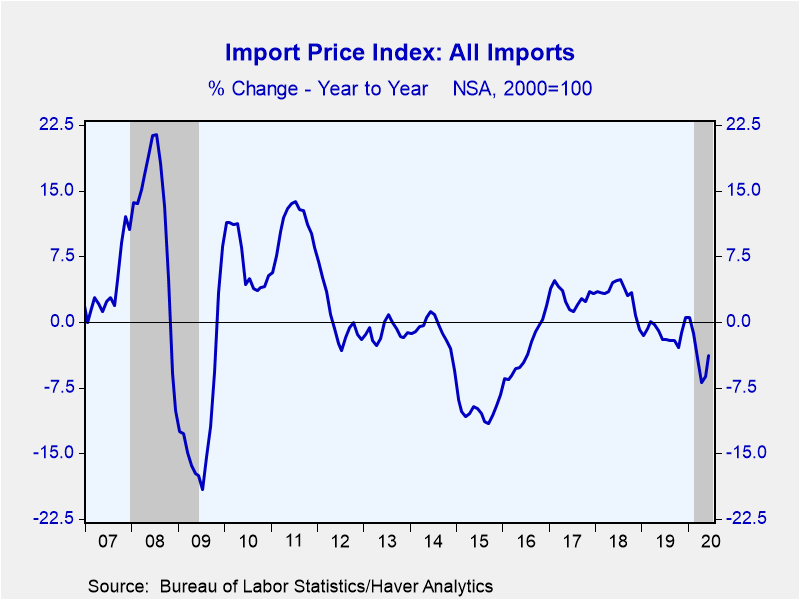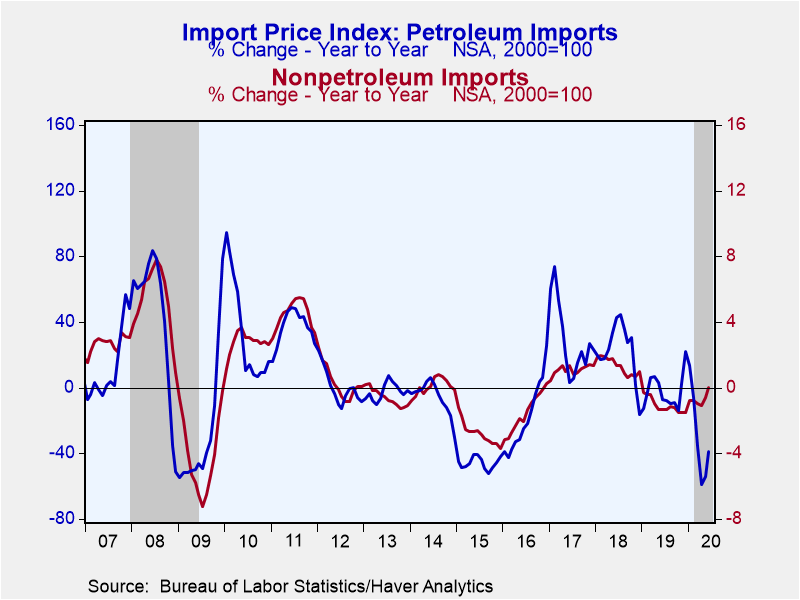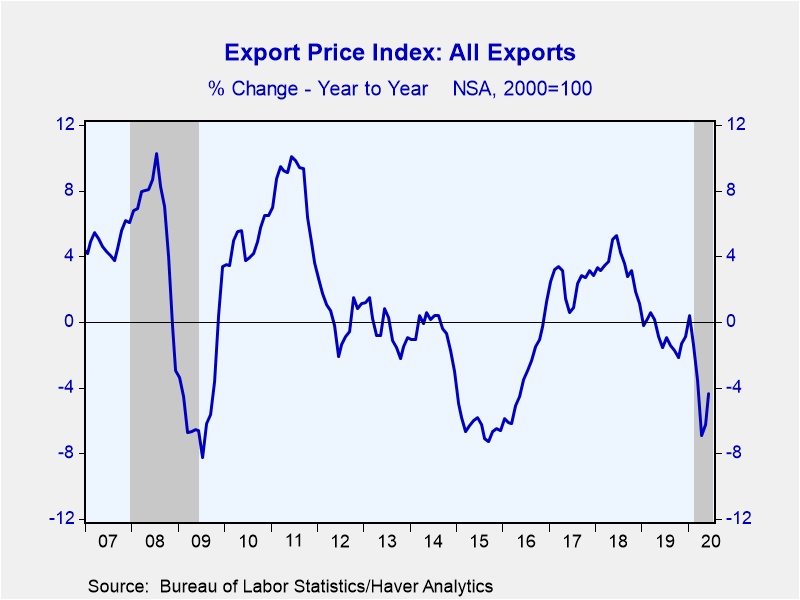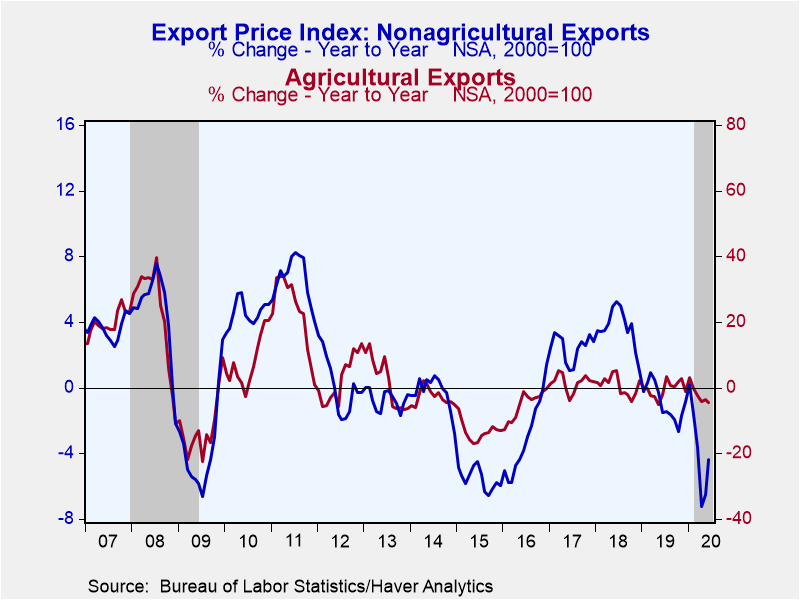 Global| Jul 15 2020
Global| Jul 15 2020U.S. Import Prices Increase Broadly in June
by:Tom Moeller
|in:Economy in Brief
Summary
• Higher oil prices add to earlier gains. • Nonoil prices improve again. • Export prices strengthen. Import prices improved 1.4% last month following a 0.8% gain during May, revised from 1.0%. A 1.0% rise had been expected in the [...]
• Higher oil prices add to earlier gains.
• Nonoil prices improve again.
• Export prices strengthen.
Import prices improved 1.4% last month following a 0.8% gain during May, revised from 1.0%. A 1.0% rise had been expected in the Action Economics Forecast Survey. These figures are not seasonally adjusted and do not include import duties.
A 23.0% surge in petroleum & petroleum product prices accounted for much of the strength last month, and it followed a 16.1% rise. Nonpetroleum import prices added 0.3% to the 0.2% gain in May. Foods, feeds & beverages edged 0.1% lower. They were unchanged y/y following a 2.3% May rise. Prices of industrial materials excluding petroleum rose 1.3% (-0.2% y/y) following three straight monthly declines. Capital goods prices rose 0.2% (-0.1% y/y) after holding steady in May but computer, peripheral & semiconductor costs rose 0.6% (-1.6% y/y). Capital goods prices excluding these technology products gained 0.1% (0.4% y/y) following a 0.1% easing. Auto, parts & engine prices slipped 0.1% (+0.5% y/y) for a second straight month and nonauto consumer goods prices edged 0.2% higher (-0.2% y/y) after holding steady in May.
Export prices rose 1.4% during June following a 0.4% May increase, revised from 0.5%. A 0.8% gain had been expected.
The rise reflected a 1.4% gain (-4.4% y/y) in nonagricultural product prices. Agricultural product prices rose the 1.4% as well (-4.5% y/y). Prices for foods, feeds & beverages recovered 1.1% (-4.4% y/y) after falling for four straight months. Industrial materials prices jumped 4.6% (-12.0% y/y) as petroleum product costs increased 21.7% (-32.2% y/y). Capital goods prices fell 0.2% (+0.4% y/y) as computer, peripheral & semiconductor prices eased 0.2% (-1.0% y/y) for a second straight month. Excluding these products, the cost of capital goods slipped 0.1% (+0.7% y/y) for a third straight month. Auto & auto product export prices improved 0.1% (-0.3% y/y) and reversed the prior month's easing while nonauto consumer goods prices held steady (-1.1% y/y) after three straight monthly declines.
The import and export price series can be found in Haver's USECON database. Detailed figures are available in the USINT database. The expectations figure from the Action Economics Forecast Survey is in the AS1REPNA database.
| Import/Export Prices (NSA, %) | Jun | May | Apr | Jun Y/Y | 2019 | 2018 | 2017 |
|---|---|---|---|---|---|---|---|
| Imports - All Commodities | 1.4 | 0.8 | -2.6 | -3.8 | -1.3 | 3.1 | 2.9 |
| Petroleum & Petroleum Products | 23.0 | 16.1 | -32.8 | -38.6 | -2.6 | 22.0 | 25.6 |
| Nonpetroleum | 0.3 | 0.2 | -0.5 | 0.0 | -1.1 | 1.3 | 1.1 |
| Exports - All Commodities | 1.4 | 0.4 | -3.4 | -4.4 | -0.9 | 3.4 | 2.4 |
| Agricultural | 1.4 | -0.5 | -3.2 | -4.5 | -0.4 | 0.6 | 1.5 |
| Nonagricultural | 1.4 | 0.5 | -3.5 | -4.4 | -0.9 | 3.7 | 2.5 |
Tom Moeller
AuthorMore in Author Profile »Prior to joining Haver Analytics in 2000, Mr. Moeller worked as the Economist at Chancellor Capital Management from 1985 to 1999. There, he developed comprehensive economic forecasts and interpreted economic data for equity and fixed income portfolio managers. Also at Chancellor, Mr. Moeller worked as an equity analyst and was responsible for researching and rating companies in the economically sensitive automobile and housing industries for investment in Chancellor’s equity portfolio. Prior to joining Chancellor, Mr. Moeller was an Economist at Citibank from 1979 to 1984. He also analyzed pricing behavior in the metals industry for the Council on Wage and Price Stability in Washington, D.C. In 1999, Mr. Moeller received the award for most accurate forecast from the Forecasters' Club of New York. From 1990 to 1992 he was President of the New York Association for Business Economists. Mr. Moeller earned an M.B.A. in Finance from Fordham University, where he graduated in 1987. He holds a Bachelor of Arts in Economics from George Washington University.










